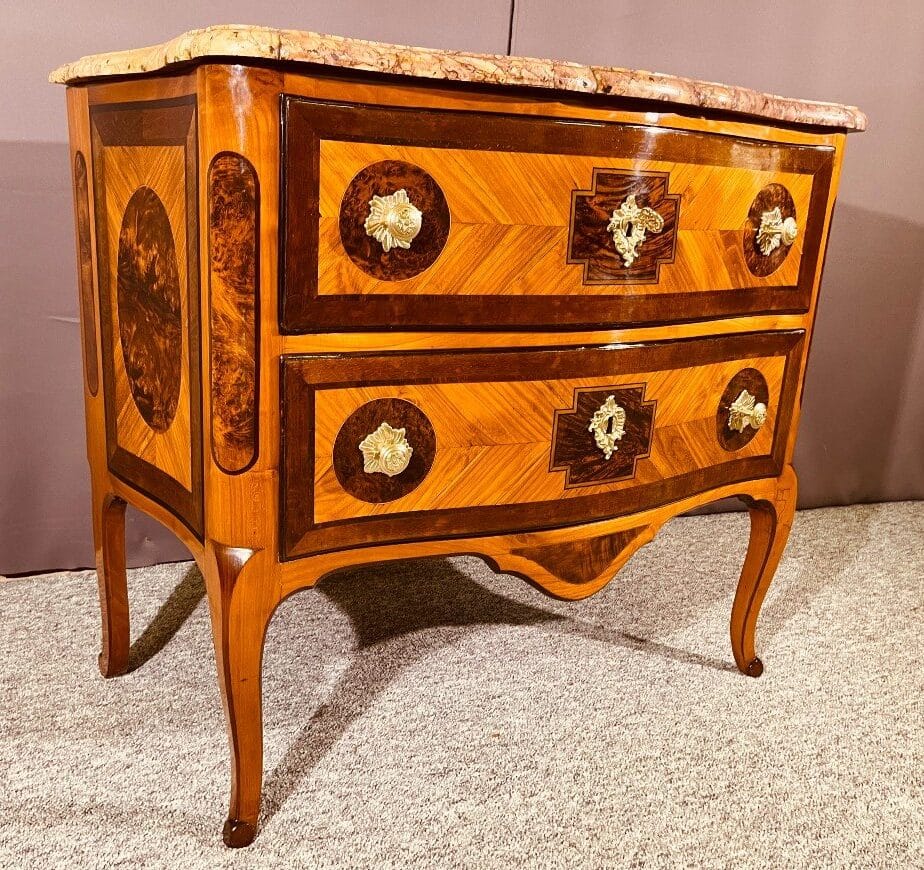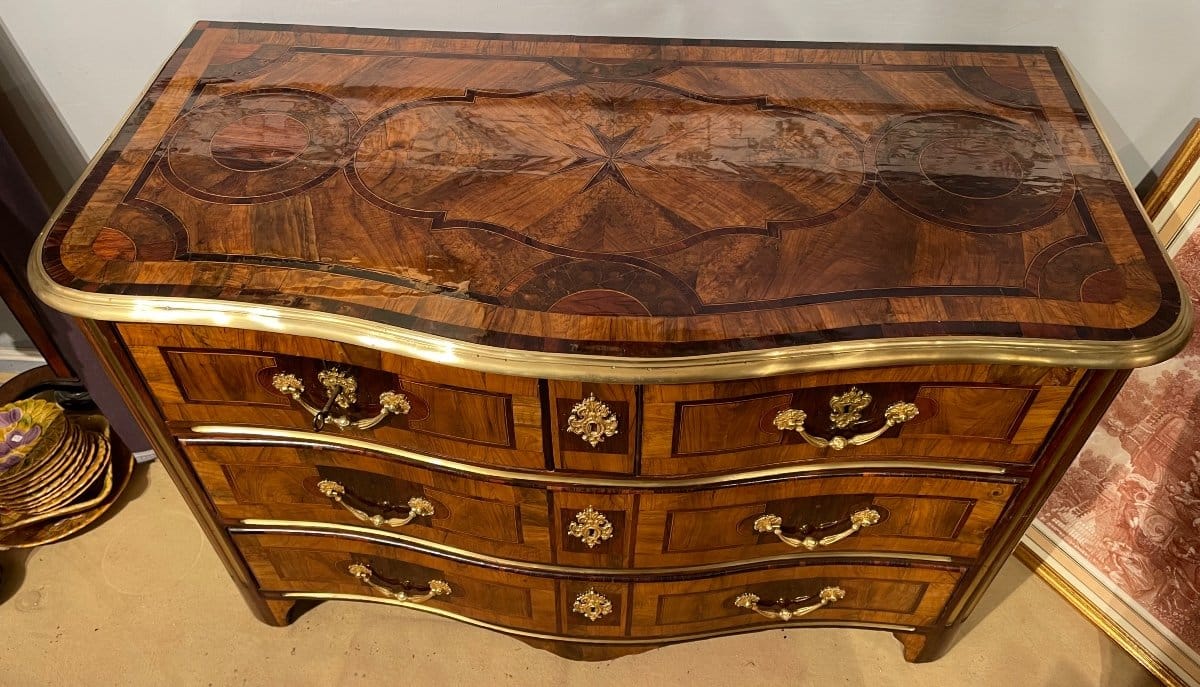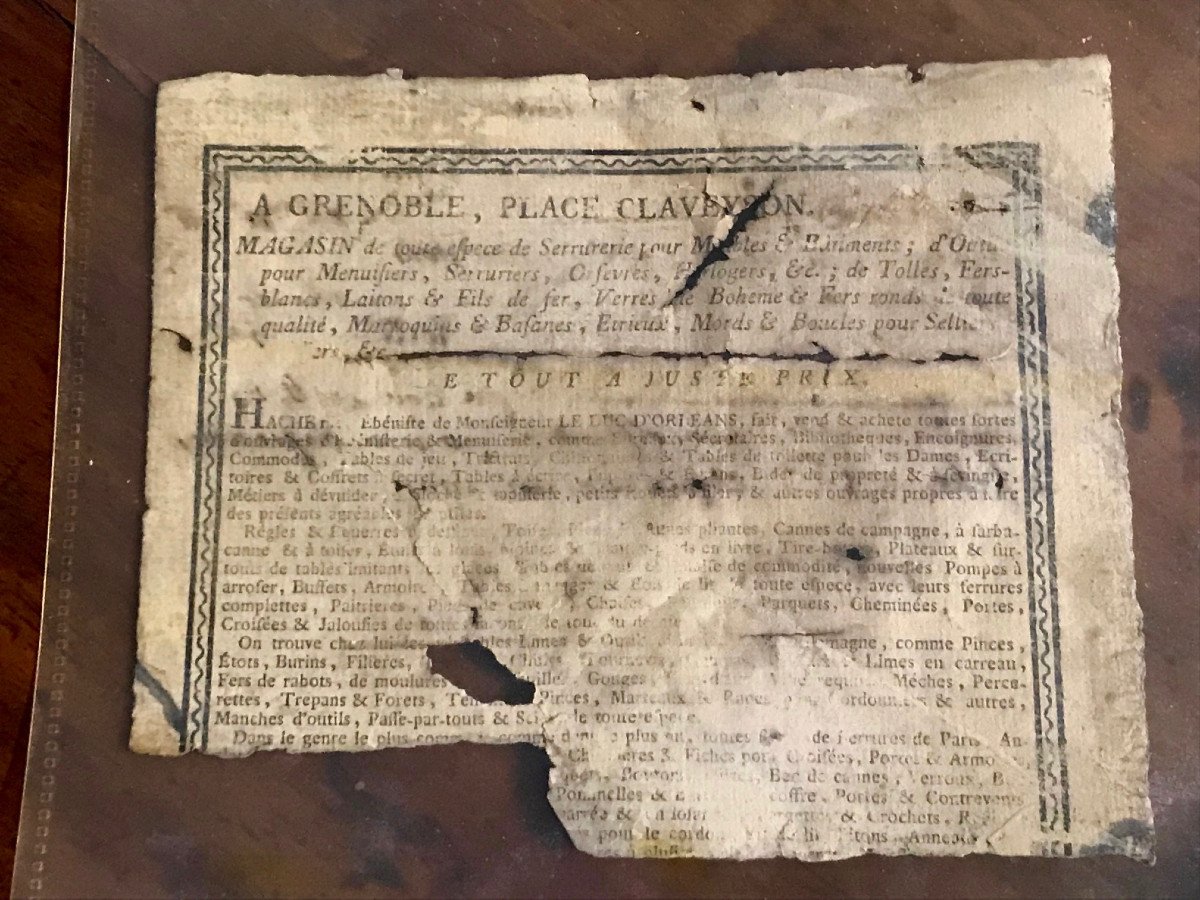
Chest of Drawers From Jean-François Hache’s Workshop © Galerie Leroy
This commode is curved on the front and on both sides. With only two drawers and long legs to carry them, this type of drawer chest is called a commode sauteuse, as if the legs were ready to spring (sauter in French).
The cabriole legs end with pastilles, characteristic of Jean-François Hache. Even the back legs are curved. A marquetry, a skillful composition with contrasting colors, decorates the drawers and the two sides with geometric patterns. Decorative all the way, it still has its original brocatelle crossbow-shaped marble top.

Brocatelle marble top enhancing the wood colors. © Galerie Leroy
All the boxes are checked to point us towards a production of the Hache workshop. There is even an old label stuck under the commode with the French city name, GRENOBLE.
The Hache Family, a Dynasty of Cabinet Makers

Changeur desk, 17th Century. Attributed to Hache in Toulouse. © Patrick Martin et Joan Pujol Antiquaires
Jean-François Hache is the fourth generation of the biggest “brand” of provincial furniture in 18th-century France. Hache (meaning ‘axe’ in French) is quite the name for a cabinetmaker family! Noël Hache (1630-1675), the first one, was born in Calais and worked in Toulouse. The next three generations (Thomas, Pierre and Jean-François) were based in Grenoble and brought fame to their name.

Commode attributed to Thomas Hache © Dupuy Antiquités
Their pieces have a strong Italian influence with intricate marquetry, even involving scagliola for Thomas Hache (1664-1747). A typical combination would be burl wood (walnut in particular as it is a major local tree in Dauphiné, the province headed by Grenoble), different types of fruitwood, and sometimes exotic woods. Some local woods may be tinted (e.g. in green).

Commode aux armoiries by Pierre Hache. Created c. 1725 for Louis d’Aymon, Lord of Franquières-le-Mollard. Visible at the Couvent Saint-Cécile in Grenoble. CC Christelle Colin
Jean-François Hache (1730-1796), the Most Famous of Them
Born January 10, 1730 in Grenoble, Jean-François is the eldest of three brothers. He became an apprentice to his father Pierre Hache (1705-1776) at the age of 16. Jean-François Hache most likely spent time with Jean-François Oeben (1721-1763), an illustrious cabinetmaker of King Louis XV, in 1755/56.

Longpra Castle with Hache woodfloor © Michel Dehaye
Jean-François started his own workshop in 1754 before taking over his father’s workshop (place Claveyson) alone in 1770. Like his father, he got appointed cabinetmaker to the Duke of Orleans, governor of Dauphiné, in 1770. He quickly gained considerable fame, and for over thirty years, he operated numerous workshops and stores in the city of Grenoble. He was a cunning business man who, on top of providing furniture for the most sumptuous Dauphinoise residences and properties, created a cheaper line of furniture made of solid walnut or cherry wood. These pieces did not include the precious marquetry Hache built their fame on but were beautiful nonetheless. Quality prevailed in all the production.

Dressing Table by Jean-François Hache © Michel-Witold Gierzod
Jean-François Hache handed over the workshop to his brother Christophe-André in 1788. Unfortunately, the end of Jean-François’ career was tarnished by a real estate scandal facilitated by all the shifts in property during the French Revolution (including the confiscation and auctioning off of Catholic Church property). Jean-François passed away in 1796. Christophe-André sold their business in 1801.
How to Spot a Jean-François Hache Piece of Furniture: Main Characteristics
- When there is marquetry: Master of high contrasts between colors and/or wood grains (high proportion of burl wood). A wealth of different woods whether local, exotic or precious woods. Started with floral marquetry (similar to his father) and moved on to geometric patterns (influence of Oeben).
- When no marquetry: Essentially walnut or cherry wood.
- Styles: Louis XV, Transition, Louis XVI.
- Many commodes, drop-front secretaries, roll-top desks.
- Feet ending with pastilles.
- All-around quality, including the assemblage and bronze mounts.
- Stamp HACHE FILS A GRENOBLE. And/or a publicity label from 1765 on.

Hache label after 1765. Titled ‘In Grenoble, Claveyson Square’. © Michel-Witold Gierzod
You May Like
Hache Furniture | 18th-Century Furniture | Chest of Drawers | Desks










